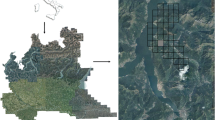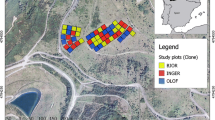Abstract
Quantitative assessment of forests is important at a variety of scales for forest planning and management. This study investigated the use of small-footprint discrete-return lidar for estimating stand volume in broad-leaved forest at plot level. Field measurements were conducted at 20 sample plots in the study area in western Japan, composed of temperate broad-leaved trees. Five height variables and two density variables were derived from the lidar data: 25th, 50th, 75th, and 100th percentiles, and mean of laser canopy heights as height variables (h 25, h 50, h 75, h 100, h mean); and ground fraction and only-and-vegetation fraction (d GF, d OVF) as density variables, defined respectively as the proportion of laser returns that reached the ground, and the proportion of only echoes (i.e., single pulse returns for which the first and last pulses returned from the same point) within vegetation points. In addition, the normalized difference vegetation index (NDVI), which is often used as an estimator for leaf area index (LAI) and above-ground biomass, was derived from multispectral digital imagery as an alternative density variable (d NDVI). Nonlinear least-square regression with cross-validation analysis was performed with single variables and combinations; a total of 23 models were studied. The best prediction was found when h 75 and d OVF were used as independent variables, resulting in adjusted R 2 of 0.755 and root-mean-square error (RMSE) of 41.90 m3 ha−1, corresponding to 16.4% of the mean stand volume, better than or comparable to the prediction models of previous studies.



Similar content being viewed by others
References
Carlson TN, Ripley DA (1997) On the relation between NDVI, fractional vegetation cover, and leaf area index. Remote Sens Environ 62:241–251. doi:10.1016/S0034-4257(97)00104-1
Drake JB, Dubayah RO, Knox RG, Clark DB, Blair JB (2002) Sensitivity of large-footprint lidar to canopy structure and biomass in a neotropical rainforest. Remote Sens Environ 81:378–392. doi:10.1016/S0034-4257(02)00013-5
Drake JB, Knox RG, Dubayah RO, Clark DB, Condit R, Blair JB, Hofton M (2003) Above-ground biomass estimation in closed canopy neotropical forests using lidar remote sensing: factors affecting the generality of relationships. Glob Ecol Biogeogr 12:147–159. doi:10.1046/j.1466-822X.2003.00010.x
Gamon JA, Field CB, Goulden ML, Griffin KL, Hartley AE, Joel G, Peñuelas J, Valentini R (1995) Relationships between NDVI, canopy structure, and photosynthesis in three California vegetation types. Ecol Appl 5:28–41. doi:10.2307/1942049
Holmgren J (2004) Prediction of tree height, basal area and stem volume in forest stands using airborne laser scanning. Scand J For Res 19:543–553. doi:10.1080/02827580410019472
Japanese Forest Agency (1970) Timber volume table. West Japan edition. J-FIC, Tokyo, p 63 (in Japanese)
Lefsky MA, Cohen WB, Acker SA, Parker GG, Spies TA, Harding D (1999a) Lidar remote sensing of the canopy structure and biophysical properties of Douglas-fir western hemlock forests. Remote Sens Environ 70:339–361. doi:10.1016/S0034-4257(99)00052-8
Lefsky MA, Harding D, Cohen WB, Parker G, Shugart HH (1999b) Surface lidar remote sensing of basal area and biomass in deciduous forests of eastern Maryland, USA. Remote Sens Environ 67:83–98. doi:10.1016/S0034-4257(98)00071-6
Lefsky MA, Cohen WB, Parker GG, Harding DJ (2002a) Lidar remote sensing for ecosystem studies. Bioscience 52:19–30. doi:10.1641/0006-3568(2002)052[0019:LRSFES]2.0.CO;2
Lefsky MA, Cohen WB, Harding DJ, Parker GG, Acker SA, Gower ST (2002b) Lidar remote sensing of above-ground biomass in three biomes. Glob Ecol Biogeogr 11:393–399. doi:10.1046/j.1466-822x.2002.00303.x
Lim K, Treitz PM (2004) Estimation of above ground forest biomass from airborne discrete return laser scanner data using canopy-based quantile estimators. Scand J For Res 19:558–570. doi:10.1080/02827580410019490
Lim K, Treitz P, Baldwin K, Morrison I, Green J (2003a) Lidar remote sensing of biophysical properties of tolerant northern hardwood forests. Can J Rem Sens 29:658–678
Lim K, Treitz P, Wulder M, St-Onge B, Flood M (2003b) LiDAR remote sensing of forest structure. Prog Phys Geogr 27:88–106. doi:10.1191/0309133303pp360ra
Maclean GA, Krabill WB (1986) Gross-merchantable timber volume estimation using an airborne lidar system. Can J Res 12:7–18
Maltamo M, Eerikäinen K, Pitkänen J, Hyyppä J, Vehmas M (2004) Estimation of timber volume and stem density based on scanning laser altimetry and expected tree size distributions functions. Remote Sens Environ 90:319–330. doi:10.1016/j.rse.2004.01.006
Means JF, Acker SA, Brandon JF, Renslow M, Emerson L, Hendrix CJ (2000) Predicting forest stand characteristics with airborne scanning lidar. Photogramm Eng Remote Sens 66:1367–1371
Morimoto Y, Njoroge JB, Nakamura A, Sasaki T, Chihara Y (2006) Role of the EXPO‘70 forest project in forest restoration in urban areas. Landsc Ecol Eng 2:119–127. doi:10.1007/s11355-006-0007-7
Næsset E (1997) Estimating timber volume of forest stands using airborne laser scanner data. Remote Sens Environ 61:246–253. doi:10.1016/S0034-4257(97)00041-2
Næsset E (2002) Predicting forest stand characteristics with airborne scanning laser using a practical two-stage procedure and field data. Remote Sens Environ 80:88–99. doi:10.1016/S0034-4257(01)00290-5
Næsset E (2004) Practical large-scale forest stand inventory using a small-footprint airborne scanning laser. Scand J For Res 19:164–179
Næsset E, Bjerknes KO (2001) Estimating tree heights and number of stems in young forest stands using airborne laser scanner data. Remote Sens Environ 78:328–340. doi:10.1016/S0034-4257(01)00228-0
Nelson R, Krabill W, Tonelli J (1988) Estimating forest biomass and volume using airborne laser data. Remote Sens Environ 24:247–267. doi:10.1016/0034-4257(88)90028-4
Nelson R, Short A, Valenti M (2004) Measuring biomass and carbon in Delaware using an airborne profiling LIDAR. Scand J For Res 19:500–511. doi:10.1080/02827580410019508
Persson Å, Holmgren J, Sôderman U (2002) Detecting and measuring individual trees using airborne laser scanner. Photogramm Eng Remote Sens 68:925–932
Popescu SC, Wynne RH, Nelson RF (2003) Measuring individual tree crown diameter with lidar and assessing its influence on estimating forest volume and biomass. Can J Rem Sens 29:564–577
Popescu SC, Wynne RH, Scrivani JA (2004) Fusion of small-footprint lidar and multispectral data to estimate plot-level volume and biomass in deciduous and pine forests in Virginia, USA. For Sci 50:551–565
Sasaki T, Imanishi J, Ioki K, Morimoto Y, Kitada K (2008) Estimation of leaf area index and canopy openness in broad-leaved forest using an airborne laser scanner in comparison with high-resolution near-infrared digital photography. Landsc Ecol Eng 4:47–55. doi:10.1007/s11355-008-0041-8
Satake Y, Hara H, Watari S, Tominari T (1989) Wild flowers of Japan: Woody plants I, II. Heibunsya, Tokyo (in Japanese)
Soininen A (2003) TerraScan User’s Guide
Tucker CJ (1979) Red and photographic infrared linear combinations for monitoring vegetation. Remote Sens Environ 8:127–150. doi:10.1016/0034-4257(79)90013-0
Wulder M (1998) Optical remote-sensing techniques for the assessment of forest inventory and biophysical parameters. Prog Phys Geogr 22:449–476
Acknowledgments
We would like to thank the staff of the Commemorative Organization for the Japan World Exposition‘70 for their support. This research was partly financed by the Organization for Landscape and Urban Green Technology Development, Japan.
Author information
Authors and Affiliations
Corresponding author
Rights and permissions
About this article
Cite this article
Ioki, K., Imanishi, J., Sasaki, T. et al. Estimating stand volume in broad-leaved forest using discrete-return LiDAR: plot-based approach. Landscape Ecol Eng 6, 29–36 (2010). https://doi.org/10.1007/s11355-009-0077-4
Received:
Revised:
Accepted:
Published:
Issue Date:
DOI: https://doi.org/10.1007/s11355-009-0077-4




